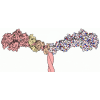+ データを開く
データを開く
- 基本情報
基本情報
| 登録情報 | データベース: PDB / ID: 6n4r | ||||||
|---|---|---|---|---|---|---|---|
| タイトル | CryoEM structure of Nav1.7 VSD2 (deactived state) in complex with the gating modifier toxin ProTx2 | ||||||
 要素 要素 |
| ||||||
 キーワード キーワード | MEMBRANE PROTEIN / voltage-gated sodium channel / gating modifier toxin | ||||||
| 機能・相同性 |  機能・相同性情報 機能・相同性情報action potential propagation / detection of mechanical stimulus involved in sensory perception / cardiac muscle cell action potential involved in contraction / node of Ranvier / voltage-gated sodium channel complex / Interaction between L1 and Ankyrins / voltage-gated sodium channel activity / detection of temperature stimulus involved in sensory perception of pain / Phase 0 - rapid depolarisation / behavioral response to pain ...action potential propagation / detection of mechanical stimulus involved in sensory perception / cardiac muscle cell action potential involved in contraction / node of Ranvier / voltage-gated sodium channel complex / Interaction between L1 and Ankyrins / voltage-gated sodium channel activity / detection of temperature stimulus involved in sensory perception of pain / Phase 0 - rapid depolarisation / behavioral response to pain / sodium channel regulator activity / neuronal action potential / axon terminus / sensory perception of pain / sodium ion transmembrane transport / post-embryonic development / calcium channel regulator activity / circadian rhythm / response to toxic substance / Sensory perception of sweet, bitter, and umami (glutamate) taste / toxin activity / inflammatory response / axon / lipid binding / extracellular region / metal ion binding / identical protein binding / plasma membrane 類似検索 - 分子機能 | ||||||
| 生物種 |  Arcobacter butzleri (バクテリア) Arcobacter butzleri (バクテリア) Homo sapiens (ヒト) Homo sapiens (ヒト)  Thrixopelma pruriens (クモ) Thrixopelma pruriens (クモ) | ||||||
| 手法 | 電子顕微鏡法 / 単粒子再構成法 / クライオ電子顕微鏡法 / 解像度: 4.2 Å | ||||||
 データ登録者 データ登録者 | Xu, H. / Rohou, A. / Arthur, C.P. / Estevez, A. / Ciferri, C. / Payandeh, J. / Koth, C.M. | ||||||
 引用 引用 |  ジャーナル: Cell / 年: 2019 ジャーナル: Cell / 年: 2019タイトル: Structural Basis of Nav1.7 Inhibition by a Gating-Modifier Spider Toxin. 著者: Hui Xu / Tianbo Li / Alexis Rohou / Christopher P Arthur / Foteini Tzakoniati / Evera Wong / Alberto Estevez / Christine Kugel / Yvonne Franke / Jun Chen / Claudio Ciferri / David H Hackos / ...著者: Hui Xu / Tianbo Li / Alexis Rohou / Christopher P Arthur / Foteini Tzakoniati / Evera Wong / Alberto Estevez / Christine Kugel / Yvonne Franke / Jun Chen / Claudio Ciferri / David H Hackos / Christopher M Koth / Jian Payandeh /  要旨: Voltage-gated sodium (Nav) channels are targets of disease mutations, toxins, and therapeutic drugs. Despite recent advances, the structural basis of voltage sensing, electromechanical coupling, and ...Voltage-gated sodium (Nav) channels are targets of disease mutations, toxins, and therapeutic drugs. Despite recent advances, the structural basis of voltage sensing, electromechanical coupling, and toxin modulation remains ill-defined. Protoxin-II (ProTx2) from the Peruvian green velvet tarantula is an inhibitor cystine-knot peptide and selective antagonist of the human Nav1.7 channel. Here, we visualize ProTx2 in complex with voltage-sensor domain II (VSD2) from Nav1.7 using X-ray crystallography and cryoelectron microscopy. Membrane partitioning orients ProTx2 for unfettered access to VSD2, where ProTx2 interrogates distinct features of the Nav1.7 receptor site. ProTx2 positions two basic residues into the extracellular vestibule to antagonize S4 gating-charge movement through an electrostatic mechanism. ProTx2 has trapped activated and deactivated states of VSD2, revealing a remarkable ∼10 Å translation of the S4 helix, providing a structural framework for activation gating in voltage-gated ion channels. Finally, our results deliver key templates to design selective Nav channel antagonists. | ||||||
| 履歴 |
|
- 構造の表示
構造の表示
| ムービー |
 ムービービューア ムービービューア |
|---|---|
| 構造ビューア | 分子:  Molmil Molmil Jmol/JSmol Jmol/JSmol |
- ダウンロードとリンク
ダウンロードとリンク
- ダウンロード
ダウンロード
| PDBx/mmCIF形式 |  6n4r.cif.gz 6n4r.cif.gz | 346.3 KB | 表示 |  PDBx/mmCIF形式 PDBx/mmCIF形式 |
|---|---|---|---|---|
| PDB形式 |  pdb6n4r.ent.gz pdb6n4r.ent.gz | 282.4 KB | 表示 |  PDB形式 PDB形式 |
| PDBx/mmJSON形式 |  6n4r.json.gz 6n4r.json.gz | ツリー表示 |  PDBx/mmJSON形式 PDBx/mmJSON形式 | |
| その他 |  その他のダウンロード その他のダウンロード |
-検証レポート
| 文書・要旨 |  6n4r_validation.pdf.gz 6n4r_validation.pdf.gz | 1 MB | 表示 |  wwPDB検証レポート wwPDB検証レポート |
|---|---|---|---|---|
| 文書・詳細版 |  6n4r_full_validation.pdf.gz 6n4r_full_validation.pdf.gz | 1 MB | 表示 | |
| XML形式データ |  6n4r_validation.xml.gz 6n4r_validation.xml.gz | 60.6 KB | 表示 | |
| CIF形式データ |  6n4r_validation.cif.gz 6n4r_validation.cif.gz | 91.2 KB | 表示 | |
| アーカイブディレクトリ |  https://data.pdbj.org/pub/pdb/validation_reports/n4/6n4r https://data.pdbj.org/pub/pdb/validation_reports/n4/6n4r ftp://data.pdbj.org/pub/pdb/validation_reports/n4/6n4r ftp://data.pdbj.org/pub/pdb/validation_reports/n4/6n4r | HTTPS FTP |
-関連構造データ
- リンク
リンク
- 集合体
集合体
| 登録構造単位 | 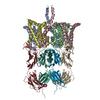
|
|---|---|
| 1 |
|
- 要素
要素
| #1: タンパク質 | 分子量: 33453.512 Da / 分子数: 4 / 由来タイプ: 組換発現 由来: (組換発現)  Arcobacter butzleri (strain RM4018) (バクテリア), (組換発現) Arcobacter butzleri (strain RM4018) (バクテリア), (組換発現)  Homo sapiens (ヒト) Homo sapiens (ヒト)株: RM4018 / 遺伝子: Abu_1752, SCN9A, NENA / 発現宿主:  Trichoplusia ni (イラクサキンウワバ) / 参照: UniProt: A8EVM5, UniProt: Q15858 Trichoplusia ni (イラクサキンウワバ) / 参照: UniProt: A8EVM5, UniProt: Q15858#2: タンパク質・ペプチド | 分子量: 3839.687 Da / 分子数: 4 / 由来タイプ: 合成 / 由来: (合成)  Thrixopelma pruriens (クモ) / 参照: UniProt: P83476 Thrixopelma pruriens (クモ) / 参照: UniProt: P83476#3: 抗体 | 分子量: 23483.910 Da / 分子数: 2 / 由来タイプ: 天然 / 由来: (天然)  #4: 抗体 | 分子量: 24523.518 Da / 分子数: 2 / 由来タイプ: 天然 / 由来: (天然)  Has protein modification | Y | |
|---|
-実験情報
-実験
| 実験 | 手法: 電子顕微鏡法 |
|---|---|
| EM実験 | 試料の集合状態: PARTICLE / 3次元再構成法: 単粒子再構成法 |
- 試料調製
試料調製
| 構成要素 | 名称: Nav1.7 VSD2 in complex with ProTx2 and an anti-Nav Fab タイプ: COMPLEX / Entity ID: all / 由来: MULTIPLE SOURCES |
|---|---|
| 分子量 | 値: 0.245 MDa / 実験値: NO |
| 由来(天然) | 生物種:  Homo sapiens (ヒト) Homo sapiens (ヒト) |
| 由来(組換発現) | 生物種:  Trichoplusia ni (イラクサキンウワバ) Trichoplusia ni (イラクサキンウワバ) |
| 緩衝液 | pH: 8 詳細: 10 mM Tris pH 8.0, 100 mM NaCl, 0.06% FA3, 0.1 mg/ml POPC:POPE:POPG mixed at molar ratio 3:1:1 |
| 試料 | 濃度: 2 mg/ml / 包埋: NO / シャドウイング: NO / 染色: NO / 凍結: YES |
| 試料支持 | 詳細: Grid was coated with a thin layer of gold / グリッドの材料: COPPER / グリッドのサイズ: 300 divisions/in. / グリッドのタイプ: C-flat-1.2/1.3 |
| 急速凍結 | 装置: FEI VITROBOT MARK IV / 凍結剤: ETHANE / 湿度: 100 % / 凍結前の試料温度: 277 K / 詳細: Apply 3 uL, blot 2.5s. Ted Pella 595 filter paper. |
- 電子顕微鏡撮影
電子顕微鏡撮影
| 実験機器 |  モデル: Titan Krios / 画像提供: FEI Company |
|---|---|
| 顕微鏡 | モデル: FEI TITAN KRIOS |
| 電子銃 | 電子線源:  FIELD EMISSION GUN / 加速電圧: 300 kV / 照射モード: FLOOD BEAM FIELD EMISSION GUN / 加速電圧: 300 kV / 照射モード: FLOOD BEAM |
| 電子レンズ | モード: BRIGHT FIELD / 倍率(公称値): 165000 X / 最大 デフォーカス(公称値): 2500 nm / 最小 デフォーカス(公称値): 1000 nm / Cs: 2.7 mm / C2レンズ絞り径: 100 µm / アライメント法: COMA FREE |
| 試料ホルダ | 凍結剤: NITROGEN 試料ホルダーモデル: FEI TITAN KRIOS AUTOGRID HOLDER |
| 撮影 | 平均露光時間: 10 sec. / 電子線照射量: 41 e/Å2 フィルム・検出器のモデル: GATAN K2 SUMMIT (4k x 4k) 撮影したグリッド数: 1 / 実像数: 25084 |
| 画像スキャン | 動画フレーム数/画像: 40 |
- 解析
解析
| EMソフトウェア |
| ||||||||||||||||||||||||||||||||
|---|---|---|---|---|---|---|---|---|---|---|---|---|---|---|---|---|---|---|---|---|---|---|---|---|---|---|---|---|---|---|---|---|---|
| CTF補正 | タイプ: PHASE FLIPPING AND AMPLITUDE CORRECTION | ||||||||||||||||||||||||||||||||
| 対称性 | 点対称性: C2 (2回回転対称) | ||||||||||||||||||||||||||||||||
| 3次元再構成 | 解像度: 4.2 Å / 解像度の算出法: FSC 0.143 CUT-OFF / 粒子像の数: 53206 詳細: Spatial frequencies higher than 8 Angstroms were not used during refinement. 対称性のタイプ: POINT |
 ムービー
ムービー コントローラー
コントローラー





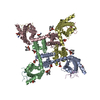

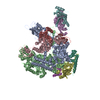
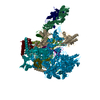
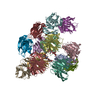
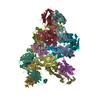

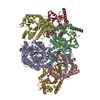

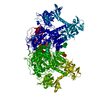
 PDBj
PDBj


